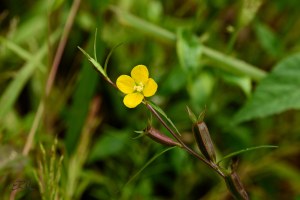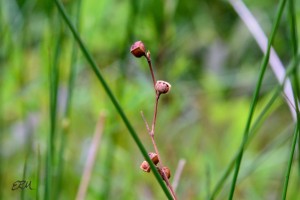 One thing or another has kept me away from botanizing in the past few weeks, but recently I did get out for a quick photo shoot along the Billy Goat C trail. I snapped a few pictures of this flower, recognizing it right aways as something in the Onagraceae (evening primrose family), and also knowing that I was probably setting myself up for failure, since identifying plants from photos never goes smoothly.
One thing or another has kept me away from botanizing in the past few weeks, but recently I did get out for a quick photo shoot along the Billy Goat C trail. I snapped a few pictures of this flower, recognizing it right aways as something in the Onagraceae (evening primrose family), and also knowing that I was probably setting myself up for failure, since identifying plants from photos never goes smoothly.
But this one did go smoothly. After just a few minutes with Weakley’s Flora I had it identified as Ludwigia decurrens (wingleaf primrose-willow). Then I checked with a few experts on-line, just to be sure, because there are no records for this species in the area where I found it.
Two weeks later I found another stand of it about a mile away from the first stand.
 Wingleaf primrose-willow is listed S2S3 (state rare) in Maryland, and despite being rare in Indiana and endangered in Pennsylvania, it’s considered weedy by some authorities. It’s a wetland species that can grow to several feet tall. The winged leaves, stem, and capsule (seedpod) distinguish it from other species of Ludwigia; indeed, the specific epithet decurrens refers to this characteristic. (In botany, “decurrent” describes leaf tissue that continues along the stem below the node where the leaf attaches.)
Wingleaf primrose-willow is listed S2S3 (state rare) in Maryland, and despite being rare in Indiana and endangered in Pennsylvania, it’s considered weedy by some authorities. It’s a wetland species that can grow to several feet tall. The winged leaves, stem, and capsule (seedpod) distinguish it from other species of Ludwigia; indeed, the specific epithet decurrens refers to this characteristic. (In botany, “decurrent” describes leaf tissue that continues along the stem below the node where the leaf attaches.)
 A closely related species, Ludwigia alternifolia, has a similar looking flower, but lacks the decurrent leaves/stems. Also, the capsule is cube-shaped, a characteristic that gives the species its common name: seedbox [below right].
A closely related species, Ludwigia alternifolia, has a similar looking flower, but lacks the decurrent leaves/stems. Also, the capsule is cube-shaped, a characteristic that gives the species its common name: seedbox [below right].
 Most of the ten species of Ludwigia found in Maryland are plants of the Coastal Plain, but these two are also found in the Piedmont, along with two others, one of which, L. peploides (floating primrose-willow), I may have found earlier this summer [above left]. However, as the plants were in standing water in the C&O Canal, I couldn’t get close enough to make a positive identification. I couldn’t get close enough to get a decent picture, either. It’s possible that this is the alien species L. grandiflora, for which there are no records in the state of Maryland, but there are records for it in every surrounding state, so who knows.
Most of the ten species of Ludwigia found in Maryland are plants of the Coastal Plain, but these two are also found in the Piedmont, along with two others, one of which, L. peploides (floating primrose-willow), I may have found earlier this summer [above left]. However, as the plants were in standing water in the C&O Canal, I couldn’t get close enough to make a positive identification. I couldn’t get close enough to get a decent picture, either. It’s possible that this is the alien species L. grandiflora, for which there are no records in the state of Maryland, but there are records for it in every surrounding state, so who knows.


















